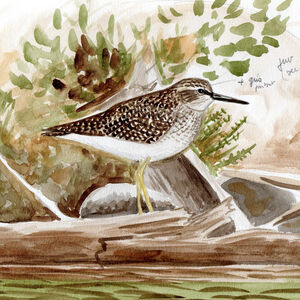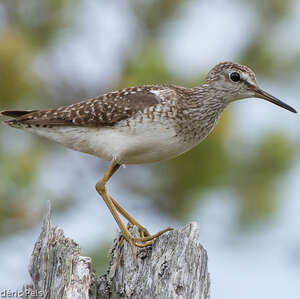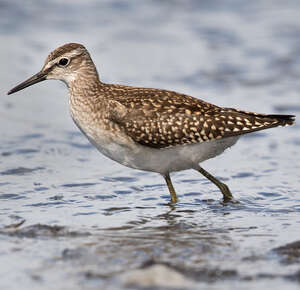Wood Sandpiper
Tringa glareola - Chevalier sylvain
Identification
The Wood Sandpiper is a bit smaller than the Common Sandpiper, more slender, with a longer neck and legs. It also has less striking plumage, paler overall and more speckled on the upperparts. With its bulging forehead and slim neck, it looks a little like a plover. Viewed in good conditions, it is easily identifiable by its silhouette and the clean pale supercilium.
Males and females are similar. The breeding adult has the upperparts in a rich brown which is patterned with light and dark markings rather than just finely speckled. The crown and nape are finely streaked with white whereas the neck and breast are white and finely streaked with brown. The 'collar effect' is not so obvious in the Wood Sandpiper. The belly and undertail are white. The flanks are whitish-cream and clearly barred with brown. The broad supercilium erases the eye-ring somewhat and the dark lores stand out. The bill, as long as the head, has a yellowish base. The long-legged tarsi are brightly yellowish-green. In flight, in stark contrast to the Common Sandpiper, it has a sharply different call, more pointed wings and most obviously lacks the bold white rump and undertail which results in less of a 'collar effect'. The tail bands are numerous, thin and brown.
The inter-breeding adult is browner and has a less spotted upper surface. The mantle feathers are edged with a thin whitish line. The breast is less streaked. The flanks still hold their dark patterning.
The juvenile is yet browner. The upperparts have mostly buff spots. The breast has a rufous colouring and is finely spotted with rufous brown. The bill is greyish and the tarsi are greenish.
Subspecific information monotypic species
Foreign names
- Chevalier sylvain,
- Andarríos bastardo,
- maçarico-de-dorso-malhado,
- Bruchwasserläufer,
- réti cankó,
- Bosruiter,
- Piro piro boschereccio,
- grönbena,
- Grønnstilk,
- kalužiak močiarny,
- vodouš bahenní,
- Tinksmed,
- liro,
- Bosruiter,
- valona,
- Flóastelkur,
- łęczak,
- purva tilbīte,
- močvirski martinec,
- Фифи,
- Trinil semak,
- タカブシギ,
- 林鹬,
- นกชายเลนน้ำจืด,
- 鷹斑鷸〔林鷸〕,
Voice song and call
The main call, for instance when they are migrating, consists of a rapid repetition of hard and sound notes kip kip kip kip.... The alarm call at the breeding grounds is a slightly less rapid repetition of kif kif kif kif... at a slightly lower tone. During courtship, the song is a modulated trill repeated for a long time triu triu triu triu triu....
Habitat
The Wood Sandpiper nests in peatlands, open wetlands of boreal forest, as well as in the ecotone between tundra and coniferous forest, wet heaths with or without scattered conifers, and in marshes with deciduous shrubs.
Outside of the breeding season, it frequents open, shallow water bodies or wetlands with mudflats where it can feed, more open than those favoured by the Common Redshank. Low-level water edges with grassy banks, muddy marshes, settling ponds, paddy fields, high ridges of dammed lakes and reservoirs, etc.. It is only rarely seen in coastal habitats such as salt marsh canals and mangroves.
Behaviour character trait
The Wood Sandpiper is more gregarious than the Common Snipe during the non-breeding season. It moves in small, loud groups, rarely alone.
Like most long-distance shorebirds, it prefers open spaces that are rich in wildlife and from which any potential danger can be seen. This is the opposite of its cousin. However, when it feeds, it does so more individually rather than making coordinated searches in groups.It is possible to observe birds at our latitudes during the summer season, mostly alone. We can think that either these are unemployed birds missing out on reproduction, or birds that have failed to reproduce and are already heading back down. On reproduction sites, adults usually perch at the top of shrubs or small trees to keep an eye on the territory.
Flight
Dietfeeding habits
The Wood Sandpiper is mainly an insectivore during breeding season. It captures all sorts of insects and their larvae, aquatic or not, such as larvae of Culicidae diptera (mosquitoes).
Otherwise, whenever possible, it variates its diet with worms (oligochaetes), crustaceans (amphipods, for example), small aquatic mollusks or moist sites, including small vertebrates (fry and little fish, tadpoles and small amphibians). It hunts a lot in plain sight, rather than probing substrates, as long-billed Sandpipers do.Reproduction nesting
The Wood Sandpiper can reproduce at the age of one. It is monogamous and territorial, and couples usually arrive already formed at the site.
The breeding period varies according to latitude, from May to July. It builds a basic nest on the ground beneath dense cover in marshes and moorlands. It is rare for the Wood Sandpiper to behave like a skulker and nest in an old nest of another species within a tree. The female usually lays four eggs. Both partners take turns incubating for 21 to 24 days. The chicks remain in the nest for a maximum of two days before leaving to explore their surroundings. They look for their own food. The parents protect them from bad weather and potential predators, but the female soon leaves the family and it is the male who will look after the brood until they are old enough to fly at about one month old. As soon as the chicks are able to fly, they move in small flocks and will not be slow to set out for their winter grounds when the time comes in August or September.Geographic range
The Wood Sandpiper breeds in the northern Eur-Asiatic continent, from Scotland and Scandinavia to the Kolyma Mountains in the far east of Russia, at boreal and subarctic latitudes. The southern limit passes through Ukraine, northern Kazakhstan and Mongolia and northeast China.
It is a great migrant. It doesn't usually winter in Europe, or only accidentally, unlike the Common Sandpiper. The main wintering grounds are in Sub-Saharan Africa up to Cape Town, the Arabian Peninsula, the Indian continent and Oceania up to the south of Australia.
Threats - protection
IUCN conservation status
concern
in the Wild
threatened
evaluated
In the past few decades this species has been in steep decline, largely due to the loss and alteration of wetlands to forestry and agriculture in the south of its range. Nevertheless, it is still common and widespread, classified as 'Not Threatened' by BirdLife International.
Sources of information
- IOC World Bird List (v15.1), Gill, F and D Donsker (Eds). 2025-12-07.
- Limicoles, gangas et pigeons d'Europe, Paul Géroudet (mise à jour Georges Olioso)
- Shorebirds, an identification guide to the waders of the world, Peter Hayman, John Marchant Tony Prater
- Avibase, Lepage Denis
- Birds of the World, The Cornell Lab of Ornithology
- xeno-canto, Sharing bird sounds from around the world,
Other sources of interest
 Specification sheet created on
25/07/2023 by Jean François
Specification sheet created on
25/07/2023 by Jean FrançoisTranslation by AI Oiseaux.net
© 1996-2025 Oiseaux.net
- Accipitriformes
- Aegotheliformes
- Anseriformes
- Apodiformes
- Apterygiformes
- Bucerotiformes
- Caprimulgiformes
- Cariamiformes
- Casuariiformes
- Charadriiformes
- Ciconiiformes
- Coliiformes
- Columbiformes
- Coraciiformes
- Cuculiformes
- Eurypygiformes
- Falconiformes
- Galliformes
- Gaviiformes
- Gruiformes
- Leptosomiformes
- Mesitornithiformes
- Musophagiformes
- Nyctibiiformes
- Opisthocomiformes
- Otidiformes
- Passeriformes
- Pelecaniformes
- Phaethontiformes
- Phoenicopteriformes
- Piciformes
- Podargiformes
- Podicipediformes
- Procellariiformes
- Psittaciformes
- Pterocliformes
- Rheiformes
- Sphenisciformes
- Steatornithiformes
- Strigiformes
- Struthioniformes
- Suliformes
- Tinamiformes
- Trogoniformes
































